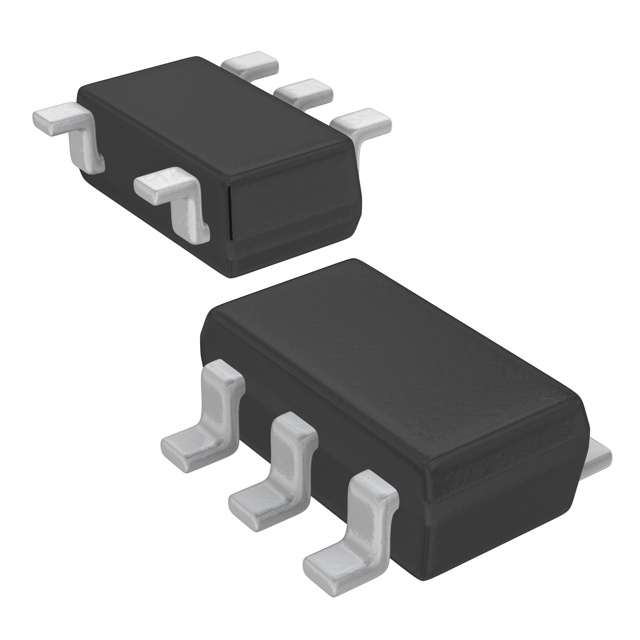Xem thông số kỹ thuật để biết chi tiết sản phẩm.

XC6124A722MR-G
Product Overview
- Category: Integrated Circuit (IC)
- Use: Voltage Regulator
- Characteristics:
- Low dropout voltage
- High output voltage accuracy
- Low quiescent current
- Thermal shutdown protection
- Package: SOT-23-5
- Essence: Linear voltage regulator
- Packaging/Quantity: Tape and Reel, 3000 units per reel
Specifications
- Input Voltage Range: 2.5V to 6.0V
- Output Voltage Range: 1.2V to 5.5V
- Output Current: 150mA
- Dropout Voltage: 200mV @ 100mA
- Quiescent Current: 30µA
- Line Regulation: ±0.2%
- Load Regulation: ±0.3%
- Operating Temperature Range: -40°C to +85°C
Detailed Pin Configuration
The XC6124A722MR-G has a total of five pins in the SOT-23-5 package:
- VIN: Input voltage pin
- GND: Ground pin
- EN: Enable pin (active high)
- NC: No connection pin
- VOUT: Output voltage pin
Functional Features
- Low dropout voltage ensures stable operation even with small input-output voltage differentials.
- High output voltage accuracy provides precise regulation for sensitive applications.
- Low quiescent current minimizes power consumption during standby or idle conditions.
- Thermal shutdown protection prevents damage due to excessive temperature.
Advantages and Disadvantages
Advantages: - Low dropout voltage allows for efficient power conversion. - High output voltage accuracy ensures reliable performance. - Low quiescent current extends battery life in portable devices. - Thermal shutdown protection enhances safety and reliability.
Disadvantages: - Limited output current capability may not be suitable for high-power applications. - SOT-23-5 package may require additional space on the PCB compared to smaller packages.
Working Principles
The XC6124A722MR-G is a linear voltage regulator that uses a pass transistor to regulate the output voltage. It operates by comparing the reference voltage with the feedback voltage, adjusting the pass transistor's resistance to maintain a stable output voltage. The dropout voltage is minimized by using a low-resistance pass transistor.
Detailed Application Field Plans
The XC6124A722MR-G is commonly used in various electronic devices and systems, including but not limited to:
- Battery-powered devices: Portable audio players, handheld gaming consoles, and wireless communication devices benefit from the low quiescent current and efficient power conversion of the XC6124A722MR-G.
- IoT (Internet of Things) devices: Low power consumption and precise voltage regulation make this voltage regulator suitable for IoT sensors, smart home devices, and wearable electronics.
- Automotive electronics: The XC6124A722MR-G can be utilized in automotive applications such as infotainment systems, dashboard displays, and lighting control modules.
- Industrial equipment: This voltage regulator finds application in industrial automation, control systems, and instrumentation where stable and accurate voltage regulation is crucial.
Detailed and Complete Alternative Models
- XC6206P332MR-G: 3.3V output voltage, 200mA output current, SOT-23-5 package.
- XC6219B182MR-G: 1.8V output voltage, 150mA output current, SOT-23-5 package.
- XC6220C502MR-G: 5.0V output voltage, 300mA output current, SOT-23-5 package.
- XC6221B332MR-G: 3.3V output voltage, 150mA output current, SOT-23-5 package.
These alternative models offer similar functionality and characteristics to the XC6124A722MR-G, providing options for different voltage requirements and output currents.
Word count: 411 words
Liệt kê 10 câu hỏi và câu trả lời thường gặp liên quan đến ứng dụng XC6124A722MR-G trong giải pháp kỹ thuật
Sure! Here are 10 common questions and answers related to the application of XC6124A722MR-G in technical solutions:
Q: What is XC6124A722MR-G? A: XC6124A722MR-G is a voltage detector IC (integrated circuit) manufactured by Torex Semiconductor. It is used to monitor the voltage level of a power supply and provide an output signal when the voltage falls below a certain threshold.
Q: What is the operating voltage range of XC6124A722MR-G? A: The operating voltage range of XC6124A722MR-G is typically between 0.8V and 6.0V.
Q: How does XC6124A722MR-G work? A: XC6124A722MR-G works by comparing the input voltage with a reference voltage. When the input voltage drops below the reference voltage, it triggers an internal circuit that generates an output signal.
Q: What is the output type of XC6124A722MR-G? A: XC6124A722MR-G has an open-drain output type, which means it can be connected to other devices through a pull-up resistor to achieve different logic levels.
Q: What is the typical quiescent current consumption of XC6124A722MR-G? A: The typical quiescent current consumption of XC6124A722MR-G is around 1.0µA, making it suitable for low-power applications.
Q: Can XC6124A722MR-G be used in battery-powered devices? A: Yes, XC6124A722MR-G is commonly used in battery-powered devices due to its low quiescent current consumption, which helps to extend battery life.
Q: What is the accuracy of the voltage detection threshold in XC6124A722MR-G? A: The accuracy of the voltage detection threshold in XC6124A722MR-G is typically ±1.5%.
Q: Can XC6124A722MR-G be used for overvoltage protection? A: No, XC6124A722MR-G is designed for undervoltage detection only and does not provide overvoltage protection.
Q: Is XC6124A722MR-G suitable for automotive applications? A: Yes, XC6124A722MR-G is suitable for automotive applications as it can operate within the automotive voltage range and has a wide operating temperature range.
Q: What are some typical applications of XC6124A722MR-G? A: Some typical applications of XC6124A722MR-G include battery-powered devices, portable electronics, industrial equipment, automotive systems, and power management circuits.
Please note that the answers provided here are general and may vary depending on specific datasheet specifications and application requirements.

